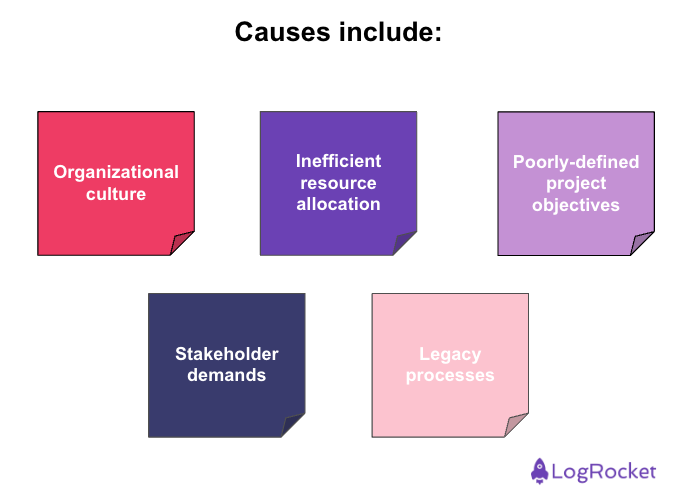Project bloat is a phenomenon that undermines project effectiveness by introducing unnecessary, excessive, or complicated procedures that hinder product development. Because of this, it’s essential for PMs to identify and address project bloat proactively.

By doing so, you can enhance employee productivity, foster improved collaboration, and ultimately drive product success.
Project bloat involves unnecessary or excessive processes and workflows that complicate product development. It can often cause additional issues like reduced productivity, delayed timelines, and a decrease in team morale.
Here are some real-life examples of project bloat:
Project bloat can manifest in various ways, but ultimately, it impacts employee productivity, innovation, and user satisfaction.
Keep in mind that project bloat differs slightly from scope creep. While both can hinder product development, they do so in different ways.
Project bloat often refers to processes, workflows, and operations that are unnecessary or not relevant. Meanwhile, scope creep refers to an expansion of a project’s scope without the formal approval of stakeholders and adjustments to company resources.
Understanding the root causes of project bloat is essential for organizations that are aiming to improve productivity and streamline workflows. Several factors can contribute to project bloat, and they can compound the issue. Common causes include:

Culture can have a significant impact on project bloat. If you’re overly cautious or don’t trust your team members, this can create excessive bureaucracy. You might believe that more processes will reduce risk and improve accountability.
However, it can have the opposite effect. It may cause team members to care more about following processes rather than delivering quality and innovative work. They may spend more time documenting their actions and getting multiple approval processes. The additional workflows may be unnecessary to effectively do their job and slow down execution.
Additional processes can also create an atmosphere of frustration, lack of trust, and micromanagement. All of these variables can create more project bloat.
Another factor of project bloat is inefficient resource allocation. Teams may find themselves unable to complete assigned tasks because they lack time, personnel, or budget. The lack of support can lead to even more delays which may be compounded by excessive bureaucracy.
Poorly-defined project objectives can also exacerbate project bloat. Vague goals, scopes, or communication can lead to multiple issues. Teams are unable to align their efforts and product managers may struggle to prioritize features. These problems complicate delivering the product and can waste time and resources.
Bigger projects mean involvement from more stakeholders. Each individual adds their own requirements and processes. When a manager doesn’t say no, it can increase the complexity of a project. Team members may struggle to understand project goals and objectives when too many stakeholders contribute.
Different stakeholders will have varying demands and expectations. Some stakeholders are overly ambitious or are misaligned with the product vision. If all stakeholders contribute, then a project can easily get overwhelmed with unnecessary tasks and features. You need to learn how to balance stakeholders with the needs of the user. Otherwise, the demands can impact workflows.
Existing processes may persist even if they lose their relevance. When processes no longer serve a useful purpose, it can lead to unnecessary complexity. Organizations may be tempted to keep existing processes out of habit. However, it’s far more beneficial to adopt efficient workflows and reduce project bloat.
Project bloat has various symptoms indicating its presence in product development. Understanding these symptoms is crucial to identifying project bloat. Early detection means you can take corrective action before project bloat takes over. Here are a few symptoms to monitor:
Knowing the signs of project bloat can help mitigate the damage before it overwhelms the product development cycle. Once you recognize you have project bloat, you can take steps to manage it.
Organizations will need to adopt several strategies to prevent project bloat. The first step is to conduct an audit of your current processes. Identify wasteful tasks and brainstorm ways to streamline workflows. You should schedule regular audits to assess the relevance and effectiveness of processes.
You may also want to consider adopting lean and agile methodologies. Applying these principles can help deliver value while minimizing bureaucracy. Many of these practices can help projects run smoothly and keep development on pace.
Company culture is also an important variable in preventing project bloat. You should encourage a culture of trust and autonomy. Team members should feel empowered to make their own decisions which will help reduce excessive approvals and documentation. Reducing micromanagement and supporting accountability is crucial for teams to operate effectively.
Clear communication is also necessary for stakeholders to understand the project goals and team responsibilities. Goals and objectives should be made clear from the start to ensure alignment on efforts.
When it comes to project bloat, the following questions tend to arise:
Project bloat is the unnecessary expansion of features and processes that hinder product development. Some examples include needing approval from multiple people or redundant meetings. Companies suffer from low productivity, stifled creativity, and delayed timelines when project bloat happens.
To avoid project bloat, regularly review workflows and streamline processes. Organizations may also consider committing to agile and lean methodologies to prevent project bloat. Other strategies include creating project goals, choosing prioritization frameworks to focus on user needs for features, and ensuring clear communication between teams.
Project bloat can be created by not trusting your employees or being overly cautious. They may develop procedures with excessive layers of approval and documentation that can hinder product development. Expansion can also cause project bloat as new stakeholders bring their own processes.
An example of project bloat includes multiple approvals for minor changes. This can slow down development. Excessive meetings can also hinder productivity. Project bloat can also manifest as complex ticketing systems that take a long time to fill out.
Addressing project bloat helps an organization create more efficient workflows and improve the productivity and morale of employees. By recognizing the symptoms of project bloat and treating the root cause, you can maintain the quality of your products without wasting resources.
A culture change may be necessary to stop the growth of project bloat. Trust your employees and provide them with autonomy. It’s also important to regularly audit workflows to ensure they are streamlined and relevant. Every step should serve a purpose. Proactive planning and monitoring can ensure teams remain responsive and agile.
Featured image source: IconScout

LogRocket identifies friction points in the user experience so you can make informed decisions about product and design changes that must happen to hit your goals.
With LogRocket, you can understand the scope of the issues affecting your product and prioritize the changes that need to be made. LogRocket simplifies workflows by allowing Engineering, Product, UX, and Design teams to work from the same data as you, eliminating any confusion about what needs to be done.
Get your teams on the same page — try LogRocket today.

A practical framework for PMs to use AI in ideation without sacrificing judgment, strategy, or decision quality.

A practical five minute revenue estimation method to help product managers compare ideas, drop low impact features, and prioritize smarter.

A practical guide for PMs who want to stop being bottlenecks, delegate smarter, and lead teams effectively with a clear ownership framework.

Stop letting unreliable data block features. Treat data as inventory to track quality, ownership, and ship with confidence.